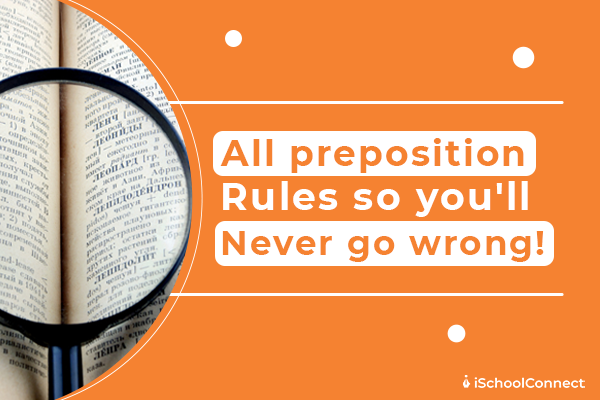Table of Contents
Given that English is the most popular language spoken worldwide, knowing the rules of effective communication is essential. Understanding the fundamental preposition rules is an excellent way to improve your fluency in the English language. This also equips you with the skills for clear communication. Regular practice and implementation of these rules can also help you use prepositions correctly and provide you good command of the English language.
Keep reading to discover the top 6 most important preposition rules in the English language!
Important preposition rules for everyday communication
Whether you are preparing for an aptitude test or just want to increase your knowledge of the English language, preposition rules contribute significantly to your efforts. In English, prepositions always indicate the relationship that a noun or pronoun has with a subject or object (or other parts of a sentence).
The right use of prepositions as per grammatical rules is as follows –
1. A preposition must have an object

- A preposition is not a preposition until and unless it relates to a noun or pronoun (that can specify as an object).
- A preposition, therefore, is always used with an object. Without an object, a proposition becomes an adverb with completely different rules.
Here is an example to better illustrate this preposition rule –
- They are in the kitchen.
The preposition connects to the object kitchen.
- There was a car after me.
The preposition after connects to the object me.
2. Add a preposition before (pre-position)
- The name ‘preposition’ indicates that this word almost always comes before its associated object.
- This is among the generally applicable preposition rules. However, it is important to note that there are exceptional cases.
For example –
- She put the toys in the box.
In this sentence, the preposition in placement is before the noun box.
- Who did you talk to?
In this sentence, the preposition is placed at the end. However, it still closely connects to the object referred to as who.
3. The pronoun that follows the preposition should be in an object form
- Among the most important preposition rules, this describes a noun or pronoun that follows a preposition. The arrangement is a ‘prepositional object.’
- With prepositional objects, the noun or pronoun needs to be in an objective form and not in a subjective form.
Here are two examples to illustrate this rule –
- Samuel gave it to them.
In this sentence, the pronoun them is written in an objective form following the preposition to.
- This is from my husband and me.
In this sentence, the pronouns after the preposition from are written in an objective form.
4. A preposition’s form
- This preposition rule stipulates the following – prepositions do not particularly have a form.
- While most prepositions are usually of one word, complex prepositions consist of two (sometimes three) words.
We can illustrate this rule with the following examples –
- Would you like to meet before lunch?
Here, the preposition before is only one word.
- She went there in spite of me telling her not to.
Here, the complex preposition in spite of comprises three words.
Other common complex prepositions used frequently include –
- But for
- According to
- On account of
5. The preposition ‘to’ and the infinitive ‘to’ are not the same!
- Among the more complex preposition rules, this criterion will help you recognize the difference between the preposition ‘to’ and the infinitive particle ‘to.’
The difference is illustrated with the following examples –
- ‘To’ as a preposition:
- They are committed to maintaining the quality of their services.
- I am used to riding bikes.
- I look forward to meeting you soon.
- ‘To’ as an infinitive particle:
- She loves to sing.
- I used to live in Europe.
- She loves to write.
6. A verb cannot be the object of a preposition

- The most important of all preposition rules describes the condition that a verb can never be the object of a preposition.
- A preposition is always followed by a noun. Under no circumstances are prepositions followed by verbs.
In this golden rule, ‘noun’ includes the following –
- Gerunds (word classes that are verbs that function as nouns)
- Noun Groups
- Pronouns
- Proper Nouns
- Regular Nouns
If a preposition is followed by a verb, the verb needs to be expressed in the -ing form, effectively converting it into a gerund.
Here are two examples to better illustrate this rule –
- These goggles are specifically designed for swimming.
In this sentence, the preposition for is followed by the gerund swimming.
- I like to shop.
In this sentence, to shop is regarded as something the individual likes doing and is not an action that is being performed.
Key Takeaways
- English is the most popular language spoken globally. Therefore, learning the rules of effective communication can be a great way to converse clearly and effectively.
- Prepositions form a small but important part of the language.
- Understanding the preposition rules listed above can be a great way to strengthen your knowledge and understanding of how to communicate in English.
If you enjoyed this blog, be sure to hit like and comment below! Reach out to us for any queries regarding English proficiency exams or consultations to study abroad.
Liked this blog? Read Important tenses rules with examples
FAQs
Q1. Why should I learn the rules of prepositions?
Answer – Learning the rules of prepositions can be an excellent way to communicate clearly and coherently anywhere. Good grammar and a grasp of the English language can be important tools in accomplishing your personal & professional goals.
Q2. Do English language proficiency exams like IELTS test preposition rules?
Answer – Yes, they do! This makes it all the more important for you to clearly understand the rules of prepositions if you are considering opportunities overseas.
Q3. Do prepositions have tense forms?
Answer – No, prepositions do not have tense forms.






